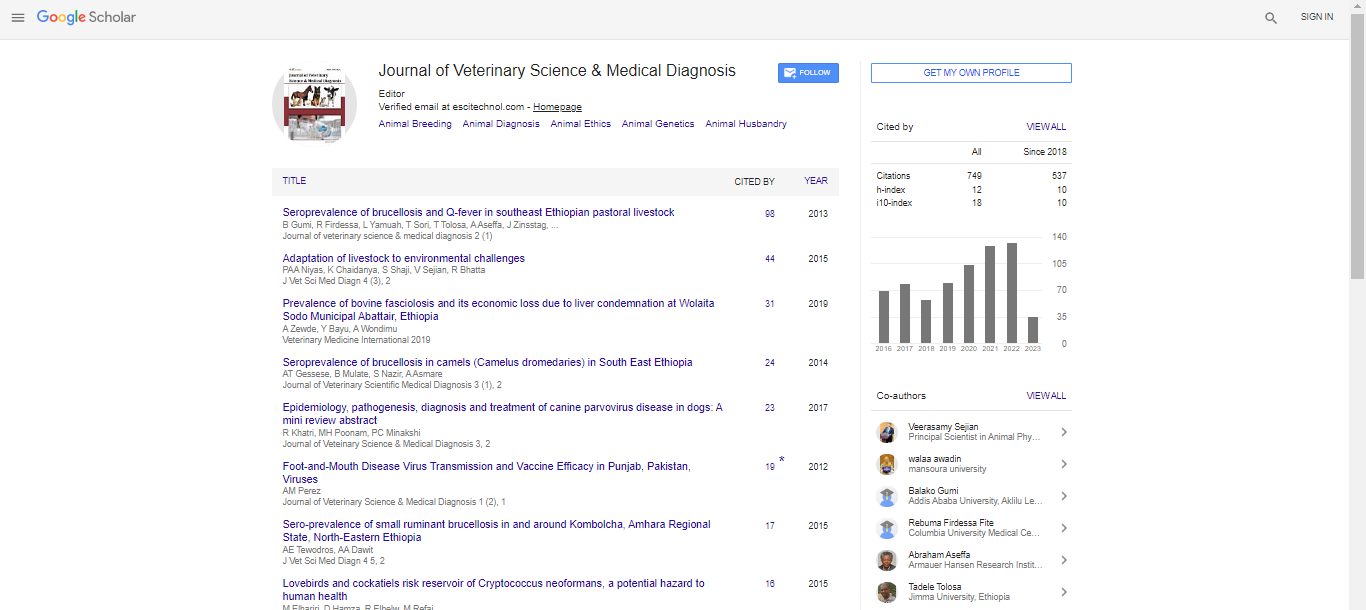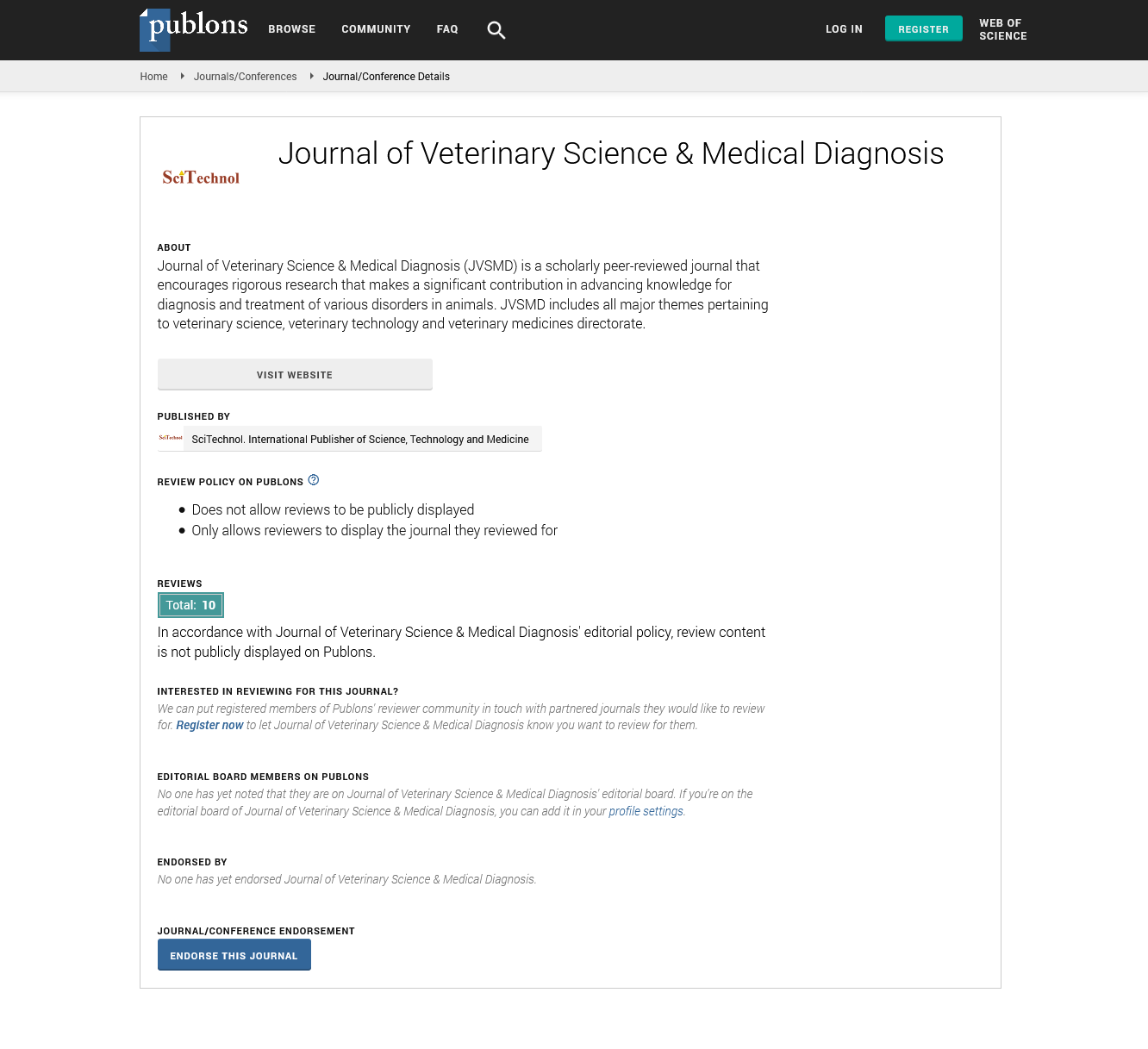Commentary, J Vet Sci Med Diagn Vol: 13 Issue: 2
Sedation in Veterinary Practice: Dosage for Exotic and Wild Animals
James Gary*
Department of Veterinary Medicine, The Ohio State University, Columbus, United States of America
- *Corresponding Author:
- Jason Ross
Department of Veterinary Medicine,
The Ohio State University,
Columbus,
United States of America;
E-mail: james@edu.ac.us
Received date: 13 March, 2024, Manuscript No. JVSMD-24-154232;
Editor assigned date: 15 March, 2024, PreQC No. JVSMD-24-154232 (PQ);
Reviewed date: 29 March, 2024, QC No. JVSMD-24-154232;
Revised date: 09 April, 2024, Manuscript No. JVSMD-24-154232 (R);
Published date: 16 April, 2024, DOI: 10.4172/2325-9590.1000094
Citation: Gary J (2024) Sedation in Veterinary Practice: Dosage for Exotic and Wild Animals. J Vet Sci Med Diagn 13:2.
Description
Sedation is a major aspect of veterinary practice, particularly when treating exotic and wild animals. These animals often have unique physiological characteristics, behaviours and responses to medications that differ from domestic species. As such, achieving the correct dosage and ensuring the safety of sedation is essential for both the welfare of the animal and the veterinarian performing the procedure. The importance of proper sedation in veterinary practice, focusing on the challenges of determining the correct dosage for exotic and wild animals.
Exotic and wild animals can present unique challenges for veterinarians. They may be fearful, stressed, or aggressive due to unfamiliar environments or handling. In many cases, sedation is necessary to facilitate medical procedures, including diagnostics, surgeries, or routine examinations, while minimizing the risk of injury to the animal or the veterinary team. Additionally, sedation allows for a more controlled and less traumatic approach to procedures, reducing the stress and anxiety experienced by the animal. In cases where sedation is insufficient, additional doses may be required, while an excessive dosage can lead to complications such as respiratory depression or cardiovascular instability.
For example, a common sedative like ketamine, often used in veterinary practices for its anesthetic and dissociative properties, requires careful dosing for exotic animals. While effective for many species, the dosage needs to be adjusted according to the animal’s weight, the procedure being performed and its species-specific response to the drug. Smaller animals, such as rodents or birds, may require much lower doses than larger species and an overdose could result in severe respiratory depression or even death. Close monitoring is essential during sedation, especially for exotic and wild animals. A veterinarian must constantly assess the animal’s response to sedation, checking vital signs such as heart rate, respiratory rate and body temperature.
Veterinarians often adjust doses based on clinical observation and the animal’s response. For example, medetomidine, a potent sedative used in wildlife sedation, can cause profound sedation in species like large cats, but the dosage must be carefully tailored to prevent overdose. Medetomidine may be reversed using an alpha-2 antagonist such as atipamezole and the veterinarian must monitor the animal's recovery to ensure the sedative wears off appropriately.
The safety and welfare of the animal are paramount when sedating exotic and wild species. Veterinarians must ensure that sedative doses are accurate to avoid unnecessary distress, side effects, or injury. Over-sedation, while reducing stress in the short term, can also suppress the animal's ability to regulate body temperature or respond to environmental stimuli, leading to long-term complications. On the other hand, under-sedation can cause anxiety, aggression, or injury to both the animal and the veterinary team.
Sedation plays a vital role in veterinary practice, especially for exotic and wild animals that require careful handling during medical procedures. Proper dosage and tailored approaches to sedation are essential for ensuring the safety and welfare of these animals. Due to the challenges posed by species diversity, veterinary professionals must have extensive knowledge of pharmacology, animal physiology and specific dosing guidelines. Constant monitoring during sedation and a balanced approach to dosage can mitigate risks, leading to safer and more effective treatment for these often vulnerable animals. As veterinary medicine continues to evolve, greater emphasis on research and training will help optimize sedation practices for exotic and wild animals, promoting their health and well-being.
 Spanish
Spanish  Chinese
Chinese  Russian
Russian  German
German  French
French  Japanese
Japanese  Portuguese
Portuguese  Hindi
Hindi 
